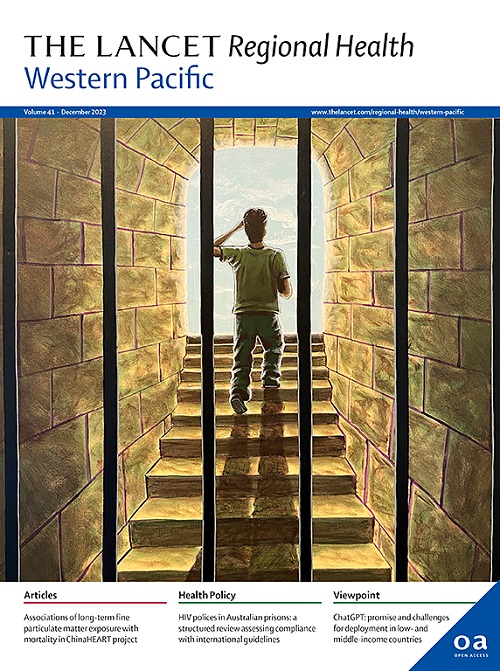气候和人口变化情景下按原因、年龄和性别分列的非最佳温度所致死亡率和发病率负担:日本全国范围的模型研究
IF 7.6
1区 医学
Q1 HEALTH CARE SCIENCES & SERVICES
引用次数: 0
摘要
背景未来温度对死亡率和发病率的影响可能有所不同。然而,在同一环境中比较预测的未来温度所致死亡率和发病率的研究十分有限。此外,这些研究并未考虑未来的人口变化、人类适应性以及亚人群易感性的变化。因此,我们同时预测了日本这个超老龄化社会在人口变化和人类适应情况下按病因、年龄和性别划分的与气温有关的死亡率和发病率。方法 我们使用日本 47 个都道府县 2015 年至 2019 年的日平均气温、死亡率和紧急救护车出动率(发病率的敏感指标)作为未来预测的参考。在都道府县一级,我们使用四种考虑到人口变化的共享社会经济路径 (SSP) 方案生成了未来的死亡率和发病率。在不同的气候变化和 SSP 情景(SSP1-2.6、SSP2-4.5、SSP3-7.0 和 SSP5-8.5)下,我们将基线值与未来温度和现有温度风险函数相结合,按病因(全因、循环系统、呼吸系统)、年龄(65 岁、≥65 岁)和性别计算了未来与温度相关的死亡率和发病率。根据经验证据,使用固定的最低死亡率或发病率百分位数(MMT)模拟了人类的完全适应,而使用固定的绝对最低死亡率或发病率百分位数模拟了人类的不适应。与此相反,与温度相关的发病率随着时间的推移而增加,这主要是由高温引起的。在 2050 年代和 2090 年代,在中度情景下,每 10 万人中有 83.69 例(95% 经验置信区间 [eCI] 38.32-124.97 例)和 77.31 例(95% 经验置信区间 [eCI] 36.84-114.47 例)全因死亡,而与非最佳气温相关的全因发病率分别为 345.07 例(95% 经验置信区间 [eCI] 258.31-438.66 例)和 379.62 例(95% 经验置信区间 [eCI] 271.45-509.05 例)。这些趋势在不同病因、年龄和性别组中基本一致。预计未来因高温引起的健康负担将大幅增加,且存在时空差异,在年龄≥65 岁的人群和男性中尤为明显。我们的研究结果有助于制定有针对性的减缓和适应战略,以有效应对未来与热有关的影响。这包括在高温期间改善救护车调度的医疗保健分配和医院预防措施,特别是针对特定的健康结果和易受影响的亚人群。本文章由计算机程序翻译,如有差异,请以英文原文为准。
Non-optimal temperature-attributable mortality and morbidity burden by cause, age and sex under climate and population change scenarios: a nationwide modelling study in Japan
Background
Future temperature effects on mortality and morbidity may differ. However, studies comparing projected future temperature-attributable mortality and morbidity in the same setting are limited. Moreover, these studies did not consider future population change, human adaptation, and the variations in subpopulation susceptibility. Thus, we simultaneously projected the temperature-related mortality and morbidity by cause, age, and sex under population change, and human adaptation scenarios in Japan, a super-ageing society.
Methods
We used daily mean temperatures, mortality, and emergency ambulance dispatch (a sensitive indicator for morbidity) in 47 prefectures of Japan from 2015 to 2019 as the reference for future projections. Future mortality and morbidity were generated at prefecture level using four shared socioeconomic pathway (SSP) scenarios considering population changes. We calculated future temperature-related mortality and morbidity by combining baseline values with future temperatures and existing temperature risk functions by cause (all-cause, circulatory, respiratory), age (<65 years, ≥65 years), and sex under various climate change and SSP scenarios (SSP1-2.6, SSP2-4.5, SSP3-7.0, and SSP5-8.5). Full human adaptation was simulated based on empirical evidence using a fixed percentile of minimum mortality or morbidity temperature (MMT), while no adaptation was simulated with a fixed absolute MMT.
Findings
A future temporal decline in mortality burden attributable to non-optimal temperatures was observed, driven by greater cold-related deaths than heat-related deaths. In contrast, temperature-related morbidity increased over time, which was primarily driven by heat. In the 2050s and 2090s, under a moderate scenario, there are 83.69 (95% empirical confidence interval [eCI] 38.32–124.97) and 77.31 (95% eCI 36.84–114.47) all-cause deaths per 100,000 population, while there are 345.07 (95% eCI 258.31–438.66) and 379.62 (95% eCI 271.45–509.05) all-cause morbidity associated with non-optimal temperatures. These trends were largely consistent across causes, age, and sex groups. Future heat-attributable health burden is projected to increase substantially, with spatiotemporal variations and is particularly pronounced among individuals ≥65 y and males. Full human adaptation could yield a decreasing temperature-attributable mortality and morbidity in line with a decreasing population.
Interpretation
Our findings could support the development of targeted mitigation and adaptation strategies to address future heat-related impacts effectively. This includes improved healthcare allocations for ambulance dispatch and hospital preventive measures during heat periods, particularly custom-tailored to address specific health outcomes and vulnerable subpopulations.
Funding
Japan Science and Technology Agency and Environmental Restoration and Conservation Agency and Ministry of the Environment of Japan.
求助全文
通过发布文献求助,成功后即可免费获取论文全文。
去求助
来源期刊

The Lancet Regional Health: Western Pacific
Medicine-Pediatrics, Perinatology and Child Health
CiteScore
8.80
自引率
2.80%
发文量
305
审稿时长
11 weeks
期刊介绍:
The Lancet Regional Health – Western Pacific, a gold open access journal, is an integral part of The Lancet's global initiative advocating for healthcare quality and access worldwide. It aims to advance clinical practice and health policy in the Western Pacific region, contributing to enhanced health outcomes. The journal publishes high-quality original research shedding light on clinical practice and health policy in the region. It also includes reviews, commentaries, and opinion pieces covering diverse regional health topics, such as infectious diseases, non-communicable diseases, child and adolescent health, maternal and reproductive health, aging health, mental health, the health workforce and systems, and health policy.
 求助内容:
求助内容: 应助结果提醒方式:
应助结果提醒方式:


